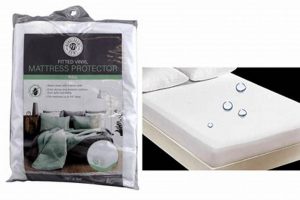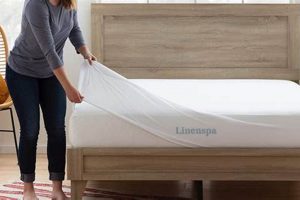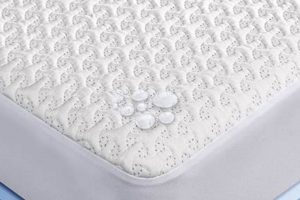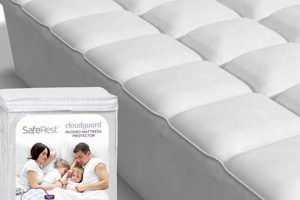A mattress protector serves as a barrier between the mattress and potential contaminants. It shields the mattress from spills, stains, dust mites, allergens, and body fluids, extending its lifespan and maintaining a cleaner sleep environment. Think of it as a washable shield that bears the brunt of daily wear and tear that would otherwise directly impact the mattress itself.
Regular cleaning of this protective layer is vital for hygiene and health. Accumulation of dust mites, allergens, and body oils can negatively impact sleep quality and exacerbate allergies or respiratory issues. Neglecting this aspect of bedding maintenance can lead to a less sanitary sleeping surface and potentially shorten the lifespan of both the protector and the underlying mattress.
The frequency with which this item should be laundered depends on several factors, including usage, lifestyle, and manufacturer recommendations. Determining an appropriate cleaning schedule will be discussed in detail, along with tips for proper washing techniques and identifying signs that indicate a more immediate need for cleaning.
Tips for Mattress Protector Maintenance
Optimizing the cleanliness and longevity of a mattress protector requires consistent and informed care. Adhering to the following guidelines ensures a more hygienic sleep environment and extends the useful life of the protector.
Tip 1: Consult Manufacturer Instructions: Always refer to the care label or manufacturer’s website for specific washing instructions. Fabric types and construction methods vary, and deviating from recommended procedures can damage the protector.
Tip 2: Establish a Regular Cleaning Schedule: A general guideline suggests laundering the protector every one to two months. However, individuals with allergies or those who sweat heavily during sleep may benefit from a more frequent washing schedule.
Tip 3: Spot Clean as Needed: Address spills or stains immediately to prevent them from setting. Use a mild detergent and a clean cloth to gently blot the affected area. Avoid harsh chemicals or abrasive cleaners.
Tip 4: Use a Gentle Detergent: Opt for a mild, hypoallergenic detergent to minimize the risk of allergic reactions and prevent damage to the protector’s fibers. Avoid detergents containing bleach or fabric softeners.
Tip 5: Wash in Cold or Warm Water: High heat can shrink or damage certain mattress protector materials. Cold or warm water is typically recommended for washing, unless the manufacturer specifies otherwise.
Tip 6: Tumble Dry on Low Heat: Excessive heat can also damage the protector during the drying process. Tumble dry on a low heat setting or air dry to preserve its integrity.
Tip 7: Inspect Regularly for Damage: Periodically examine the protector for tears, holes, or deterioration. A damaged protector compromises its ability to protect the mattress and should be replaced.
Consistent implementation of these care tips contributes to a cleaner, healthier sleep environment and protects the investment made in both the mattress and its protective cover.
The following sections will explore additional factors influencing cleaning frequency and offer advice on selecting the right type of protector for individual needs.
1. Monthly
The concept of “monthly” serves as a baseline recommendation in the context of mattress protector maintenance. It establishes a general timeframe for routine cleaning, providing a starting point for individuals to tailor their washing schedule based on specific needs and circumstances.
- Standard Usage and Hygiene
For individuals without specific health concerns or lifestyle factors that necessitate more frequent cleaning, a monthly wash cycle helps maintain a reasonable level of hygiene. This interval prevents the excessive accumulation of dust, dead skin cells, and minor spills, ensuring a cleaner sleeping surface.
- Preventative Allergen Control
While not as intensive as more frequent cleaning, a monthly wash cycle can still contribute to allergen control. It reduces the build-up of dust mites and other allergens that can trigger allergic reactions or respiratory issues. This proactive approach is beneficial for those with mild sensitivities.
- Extending Mattress Lifespan
By consistently removing contaminants and preventing them from penetrating the mattress, a monthly cleaning schedule aids in preserving the mattress’s condition. This protective measure contributes to the longevity of the mattress, safeguarding it from stains, odors, and other forms of degradation.
- Balancing Convenience and Cleanliness
A monthly cleaning schedule strikes a balance between the need for hygiene and the practicalities of laundry routines. It offers a manageable timeframe that most individuals can incorporate into their regular household chores without feeling overwhelmed.
The “monthly” guideline is a pragmatic approach to maintaining a clean and hygienic sleep environment. While it may need adjustment based on individual circumstances, it provides a solid foundation for establishing a consistent and effective mattress protector care routine.
2. Allergies
Allergies significantly impact the recommended frequency of mattress protector laundering. The accumulation of allergens within bedding can exacerbate allergic symptoms, necessitating a more rigorous cleaning schedule. Dust mites, pet dander, pollen, and mold spores are common allergens that readily collect in fabric. These microscopic particles trigger immune responses in susceptible individuals, leading to symptoms such as sneezing, coughing, watery eyes, and skin irritation. A mattress protector, while designed to shield the mattress, becomes a reservoir for these allergens over time.
Individuals with known allergies or sensitivities should launder their mattress protectors more frequently than the standard one-to-two month interval. A weekly or bi-weekly cleaning schedule may be necessary to effectively control allergen levels. Consider, for instance, a child with asthma who experiences nighttime coughing and wheezing. Regular washing of the mattress protector helps reduce exposure to dust mites, potentially alleviating these symptoms. Similarly, individuals allergic to pet dander who allow pets on their beds will benefit from more frequent laundering to remove accumulated allergens.
In summary, the presence of allergies directly influences the frequency with which a mattress protector should be washed. A proactive approach to allergen control through more frequent laundering can significantly improve sleep quality and reduce allergic symptoms. Failure to address allergen accumulation can lead to chronic discomfort and exacerbate existing respiratory conditions, underscoring the importance of tailoring the washing schedule to individual allergy profiles.
3. Spills
The occurrence of spills directly dictates the urgency and frequency with which a mattress protector requires laundering. Any liquid intrusion poses a potential risk to both the protector and the underlying mattress, necessitating immediate action to prevent lasting damage and maintain hygiene.
- Immediate Contamination and Staining
Spilled liquids, such as beverages or bodily fluids, can quickly penetrate the fabric of the protector, leading to staining and the potential for bacterial growth. Delaying cleaning allows the stain to set, making removal more difficult and potentially compromising the protector’s appearance and functionality. The longer the spill remains untreated, the greater the risk of permanent discoloration and odor retention.
- Preventing Mattress Damage
The primary function of a mattress protector is to shield the mattress from spills and other forms of contamination. However, a saturated protector can fail to provide adequate protection, allowing liquids to seep through and damage the mattress. This can result in irreversible staining, unpleasant odors, and the growth of mold or mildew within the mattress, necessitating professional cleaning or even replacement.
- Maintaining Hygiene and Preventing Odors
Spills, particularly those involving bodily fluids, create an ideal environment for bacterial and fungal growth. These microorganisms can lead to unpleasant odors and pose a potential health risk. Prompt laundering of the protector eliminates these contaminants, ensuring a clean and hygienic sleep environment. Failing to address spills promptly can result in persistent odors and a breeding ground for harmful bacteria.
- Type of Spill and Cleaning Requirements
The nature of the spilled liquid influences the appropriate cleaning method. For instance, acidic spills, such as juice or vomit, require immediate attention to prevent fabric damage and discoloration. Similarly, spills containing fats or oils may necessitate the use of specialized detergents to effectively remove the residue. Different types of spills demand tailored cleaning approaches to ensure complete removal and prevent lasting damage to the protector.
In conclusion, spills necessitate an immediate deviation from a routine cleaning schedule. The prompt and appropriate laundering of a mattress protector following any spill is crucial for preventing staining, mattress damage, odor development, and maintaining a hygienic sleep environment. The specific cleaning method should be tailored to the type of liquid spilled to ensure complete removal and prevent lasting damage.
4. Sweating
Nocturnal perspiration, commonly referred to as night sweats, significantly influences the frequency with which a mattress protector should be laundered. The human body naturally regulates temperature, often resulting in perspiration during sleep. While the amount of sweat produced varies among individuals, factors such as ambient temperature, bedding materials, certain medical conditions, and medications can exacerbate this process. Excessive sweating during sleep deposits moisture, salts, and body oils onto bedding, including the mattress protector. This creates an environment conducive to the growth of bacteria, mold, and mildew, potentially leading to unpleasant odors and skin irritation. For example, an individual undergoing hormone therapy may experience increased night sweats, necessitating more frequent cleaning of bedding.
The regular removal of accumulated perspiration through laundering is crucial for maintaining hygiene and preventing the degradation of the mattress protector. The build-up of moisture can weaken fabric fibers, reducing the protector’s effectiveness and lifespan. Furthermore, the presence of bacteria and mold can trigger allergic reactions or exacerbate respiratory conditions in sensitive individuals. Consider the case of an athlete who engages in rigorous training; their increased metabolic rate may result in more profuse sweating during sleep, requiring a more frequent washing schedule to prevent the accumulation of sweat and associated odors. Failing to adequately address perspiration build-up can ultimately compromise the protector’s ability to shield the mattress from stains and damage, defeating its primary purpose.
In conclusion, the degree of nocturnal perspiration is a critical factor in determining an appropriate laundering frequency. Individuals who experience frequent or excessive night sweats should adopt a more rigorous cleaning schedule, potentially washing their mattress protector weekly or bi-weekly, to ensure a clean and hygienic sleep environment. Ignoring the impact of sweating can lead to a compromised sleep surface, increased allergen exposure, and a reduced lifespan for both the mattress protector and the underlying mattress.
5. Pet Dander
Pet dander, composed of microscopic flecks of skin shed by animals with fur or feathers, is a potent allergen that significantly impacts the frequency with which a mattress protector should be laundered. These particles, often carrying saliva and urine residue, readily become airborne and settle on surfaces throughout the home, including bedding. The presence of pets in the sleeping environment, particularly those allowed on the bed, introduces a continuous source of dander, necessitating a more rigorous cleaning schedule to maintain hygiene and mitigate allergic reactions. For instance, a household with a cat that sleeps on the bed will experience a higher concentration of dander on the mattress protector compared to a pet-free home, thus requiring more frequent washing.
The accumulation of pet dander on a mattress protector can trigger allergic symptoms in sensitive individuals, leading to respiratory issues, skin irritation, and disrupted sleep. Regular laundering removes these allergens, reducing exposure and minimizing the risk of adverse reactions. The effectiveness of a mattress protector as a barrier against allergens diminishes as it becomes saturated with dander, underscoring the importance of consistent cleaning. Consider a scenario where a dog owner notices increased sneezing and congestion in their child, who shares a bed with the family pet. More frequent washing of the mattress protector could alleviate these symptoms by reducing the child’s exposure to canine dander. Choosing allergen-resistant mattress protectors can further help.
In conclusion, pet dander is a primary determinant of how often a mattress protector should be washed in households with pets. A proactive approach to dander removal through regular laundering is essential for maintaining a healthy sleep environment, minimizing allergic reactions, and preserving the integrity of the mattress. Failure to address dander accumulation can lead to chronic allergy symptoms and compromise the overall hygiene of the bedding. The frequency of cleaning should be adjusted based on the number of pets, their shedding levels, and the sensitivity of individuals to pet allergens within the household.
6. Manufacturer
The mattress protector manufacturer’s guidelines are a primary determinant of the appropriate cleaning frequency. Material composition, construction techniques, and specific treatments applied to the protector influence its durability and response to various laundering processes. Deviating from the manufacturer’s recommendations can result in damage, shrinkage, or a reduction in the protector’s effectiveness. For instance, a protector made with a waterproof membrane may require specific detergents or drying temperatures to maintain its integrity, information solely provided by the manufacturer. Therefore, the manufacturer’s instructions supersede general cleaning guidelines, serving as the definitive source for optimal care.
Ignoring the manufacturer’s advice can have tangible negative consequences. Overly aggressive washing or drying cycles can degrade the protective qualities of the material. For example, using bleach on a protector not designed for it might compromise its waterproof barrier. Failure to follow specific temperature recommendations during washing and drying can cause shrinkage, rendering the protector ill-fitting and ineffective. Real-world examples of damaged protectors due to improper care demonstrate the practical significance of adhering to manufacturer’s recommendations. Some manufacturers even provide extended warranties contingent upon adherence to specified cleaning protocols.
In summary, the manufacturer’s guidelines are not merely suggestions but essential instructions for maintaining a mattress protector’s performance and longevity. Understanding and implementing these recommendations ensures that the protector continues to function as intended, safeguarding the mattress and providing a hygienic sleep environment. Disregarding this information can lead to premature degradation and invalidate any warranty claims, highlighting the crucial role the manufacturer plays in determining the appropriate laundering frequency and methods. The manufacturer’s recommendations is the best way to know how often should you wash a mattress protector.
7. Stains
The presence of stains on a mattress protector directly correlates with the urgency and frequency of laundering. Stains, resulting from spills, bodily fluids, or other contaminants, not only compromise the aesthetic appearance of the protector but also pose potential hygiene risks. Delaying stain removal allows the staining agents to penetrate deeper into the fabric, increasing the difficulty of subsequent cleaning and potentially fostering microbial growth. Untreated stains can also serve as a food source for dust mites, exacerbating allergen concerns. For instance, a coffee spill left unattended on a mattress protector will not only result in a visible stain but also create a sticky residue that attracts dust and other debris.
Prompt action is critical to prevent permanent staining and maintain a sanitary sleep environment. Spot cleaning should be performed immediately upon the occurrence of any spill or stain. However, if the stain is extensive or resistant to spot cleaning, the entire mattress protector should be laundered. The type of staining agent dictates the appropriate cleaning method. Blood stains, for example, require cold water and enzymatic detergents, while grease stains may necessitate the use of specialized stain removers. The failure to address stains promptly can lead to irreversible discoloration and degradation of the fabric, potentially shortening the lifespan of the protector and compromising its ability to shield the mattress.
In conclusion, stains necessitate a deviation from a routine cleaning schedule. The prompt and appropriate laundering of a mattress protector following any staining incident is crucial for preventing permanent damage, maintaining hygiene, and preserving the protector’s functionality. The specific cleaning method should be tailored to the nature of the staining agent to ensure complete removal and prevent lasting discoloration or degradation. A proactive approach to stain management is essential for prolonging the lifespan of the mattress protector and safeguarding the integrity of the underlying mattress.
Frequently Asked Questions
This section addresses common inquiries regarding the proper care and cleaning frequency of mattress protectors. It provides concise, fact-based answers to help ensure optimal hygiene and prolong the lifespan of both the protector and the mattress.
Question 1: What factors determine the appropriate cleaning interval?
Several factors influence the ideal cleaning schedule, including the presence of allergies, the occurrence of spills, the level of nocturnal perspiration, the presence of pets, and the manufacturer’s recommendations. Individuals with allergies or those who experience frequent night sweats may require more frequent cleaning.
Question 2: Is there a standard recommendation for cleaning frequency?
A general guideline suggests laundering the mattress protector every one to two months. However, this interval should be adjusted based on individual circumstances and the factors mentioned above.
Question 3: Can improper washing techniques damage the protector?
Yes. Deviating from the manufacturer’s instructions, such as using excessively high heat or harsh detergents, can damage the protector’s fabric or waterproof membrane, reducing its effectiveness and lifespan.
Question 4: How should spills be addressed?
Spills should be addressed immediately. Spot clean the affected area with a mild detergent and water. If the spill is extensive or resistant to spot cleaning, launder the entire protector according to the manufacturer’s instructions.
Question 5: Is it necessary to wash a new mattress protector before first use?
While not always mandatory, washing a new mattress protector before first use is advisable. This removes any residual chemicals or manufacturing debris, ensuring a cleaner and more comfortable sleeping surface.
Question 6: How does the type of mattress protector influence cleaning requirements?
The material composition of the mattress protector dictates the appropriate cleaning methods. Always consult the manufacturer’s instructions for specific guidance on washing and drying procedures. Different materials may require different detergents, water temperatures, and drying settings.
Proper mattress protector maintenance is essential for maintaining a hygienic sleep environment and protecting the investment in the mattress. Adhering to the manufacturer’s recommendations and adjusting the cleaning frequency based on individual needs ensures optimal performance and longevity.
The following section will explore different types of mattress protectors and their suitability for various needs and preferences.
Determining Mattress Protector Cleaning Frequency
This discussion has explored the various factors influencing the appropriate laundering schedule for mattress protectors. Key considerations include the presence of allergies, occurrence of spills, level of nocturnal perspiration, existence of pets in the sleeping environment, the appearance of stains, and crucially, the manufacturers care instructions. Acknowledging these variables allows for the establishment of a cleaning regimen tailored to specific needs and circumstances.
Consistent adherence to a well-considered cleaning schedule is vital for maintaining a hygienic sleep environment and extending the lifespan of both the mattress protector and the underlying mattress. Prioritizing this aspect of bedding maintenance contributes to improved sleep quality and overall well-being. Regular assessment of individual needs and diligent execution of appropriate care practices are paramount.







